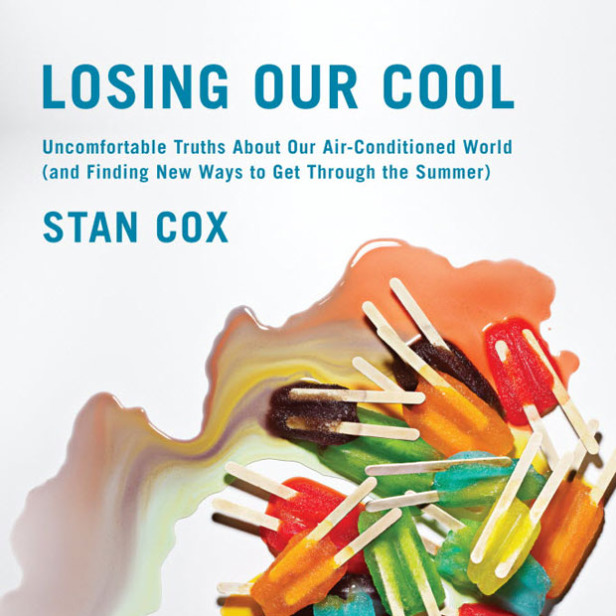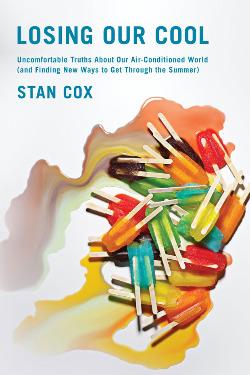When you think of the causes of global warming, you may picture an SUV before you picture a central AC unit. But almost 20 percent of electricity consumption in U.S. homes goes to AC — that’s as much electricity as the entire continent of Africa uses for all purposes. So says Stan Cox in his new book, Losing Our Cool: Uncomfortable Truths About Our Air-Conditioned World (and Finding New Ways to Get Through the Summer).
Cox, a scientist and agricultural researcher who lives in Salina, Kansas, doesn’t paint AC as the bogeyman. Rather, he makes the point that our world has developed in many unsustainable directions overall, and air-conditioning has been a crucial part of that development. He also argues that making air-conditioners and other appliances more energy efficient isn’t going to get us out of this mess. He spoke to Grist last week about his new book. Open a window, undo a button, and enjoy …
—–
Q. Why did you write a book on air-conditioning?
A. In the past half-century, a number of big, energy-guzzling technologies have really changed our lives: automobiles, computers, television, jet aircraft. All that time, air-conditioning has been humming away in the background, like a character actor you see in a whole bunch of movies. It’s never the star, but it always seems to be there moving the plot along.
When I looked at the doubling in the amount of electricity used for air conditioning homes in this country just since the mid-90s, I thought, we really need to address this, because it is a big contributor to greenhouse-gas release and it’s going to increase the likelihood that we’re going to have longer, more intense heat waves and hotter summers in the future, and we’re going to have to be running the air-conditioning even more.
Q. That seemed to be a theme throughout the book — that the use of air-conditioning leads to a cycle where it needs to be used more.
A. Yes, the biggest example of that is probably global warming. But there are a lot of ways in which air-conditioning creates need for itself, including by eroding our heat tolerance. Once we’ve built office buildings and commercial buildings on the assumption of air-conditioning, then we pretty much have to use it. We’ve created a lot of space that’s almost uninhabitable without it. In many buildings, the windows don’t open at all anymore.
In the book, I put a lot of emphasis on what’s known as the adaptive model of comfort. It’s based on surveys of people who are working at different temperatures and asked if they’re comfortable. People can psychologically adjust to buildings that are cooler in the winter and warmer in the summer. The comment I’ve heard most since the book came out is from people who work in offices and complain that their offices are too cold in the summer, and they have to take sweaters or use space heaters, wasting even more energy. Without eroding people’s working conditions or quality of life at all, there could be a big savings there.
Q. I thought it was interesting that you linked AC to obesity, in the sense that people are indoors more often and their bodies don’t have to work to adjust to the temperature changes during the year.
A. Right, that’s one of the hypotheses that a group of medical researchers came up with to explain the rise in obesity — the slower burning of energy by the body in the comfort range, where it doesn’t have to work to either shed heat or generate heat (in addition to the normal explanations that people are eating more and exercising less). Another way AC could be affecting obesity is that people tend to eat more when in cooler conditions. And also, by making the indoors more attractive in the summertime, we’ve made it less likely that people are going to be outdoors where we’re more physically active.
Q. Has the advent of AC led to more social isolation, where we’re within our own homes and don’t interact as much with the community?
A. That’s right. Starting in the South, which led the nation into air-conditioning, you had the erosion of what they called the front-porch culture — neighbors would drop in on each other when they saw them sitting on the porch, kids would be running up and down the block.
[In the book, there’s] an anecdote from a friend of mine who was out in her yard on a June day in Kansas when the power went out, and people started drifting out of their houses, and it sort of turned into an impromptu block party. She noticed nobody seemed to be going in to call the power company. Instead they’d seized the opportunity to socialize and get out of their cold isolation.
Q. AC has spurred a huge migration to hotter climates and drier climates.
A. It has allowed us to put cities in very fragile ecological zones like the desert area where Phoenix is, or the fringes of the Everglades, or actually out into the Everglades now in South Florida. We build up these big Sun Belt cities on the assumption of air-conditioning, so there’s limited green space. The heat island effect becomes pretty overwhelming — all the asphalt, concrete, and steel are trapping heat that’s then released throughout the night. In Phoenix you can easily have a lot of nights where the temperature never drops below 90, while in the normal desert climate you get a big drop in temperature.
By virtue of the fact that there was so much cheap land in the Sun Belt, there’s been this huge migration from the north and there’s much more sprawl in Sun Belt cities, so they’re generally more dependent on automobiles. When drivers are stuck in freeway traffic jams, they’re using the AC. So you have again this vicious circle where the kind of development that air-conditioning has fostered in the Sun Belt cities requires the use of even more air-conditioning.
 Stan CoxQ. You write that energy efficiency is not the answer to our problems. Why?
Stan CoxQ. You write that energy efficiency is not the answer to our problems. Why?
A. The way economies work, efficiency and total consumption of energy always tend to rise together. Having greater energy efficiency, as a friend of mine likes to say, is like putting energy on sale. We’ll find more ways to use it.
Since the mid-90s, residential air-conditioners have increased in efficiency by 28 percent, but the amount of energy used to cool the average household in the U.S. has increased by 37 percent. Part of the reason is that house size has increased dramatically — we’re cooling much more square footage per house. And we’ve had hotter summers, and more people are turning to central air rather than room cooling. If it had been more expensive to heat and cool a house, we probably wouldn’t have had people wanting to build bigger and bigger houses.
There’s nothing wrong with greater efficiency, but that has to be preceded by a commitment to put some very hard limits on the total amount of energy or other resources that we’re
going to use. That limit is going to have to be decreased year by year.
I didn’t write the book to call for a ban on air-conditioning, but if we take the sensible route and put overall limits on consumption, then people and businesses might see air-conditioning as a very good place to start cutting back, if they think about some of what we’ve lost in the age of air-conditioning.
Q. You make the case that we have to cut back our growth and our consumption, but that’s not compatible with the way our capitalist economy functions. So what is the potential solution to this?
A. Everybody in a position of power is talking about how to get economic growth racing ahead again, because that’s simply the way capitalist economies work — they have to have continuous growth. Despite some of the things you hear, that growth in the GDP is always going to be linked to growth in consumption of material resources and the generation of waste. Profits have to be generated, and they have to grow not just in the linear fashion, but by a certain percentage each year, and the bigger the economy gets, the more it has to grow in a given year to achieve that percentage. We’re reaching the edge of the petri dish here. A lot of footprint analyses show we’re already consuming more than one planet can provide. I cite one study by a professor at the University of Utah showing that even in the greenest scenario, using the best green technology, renewable energy and so forth, to stay below 450 ppm CO2, the world economy is going to have to shrink by 1 to 4 percent per year over the next 40 years. We’re going to have to have a different economic system, which is much easier said than done.
And the other thing we’re going to have to have, which nobody is going to like, is a pretty massive transfer of wealth from wealthy individuals, areas, or countries to those that are less wealthy. When you say we have to reduce the output of the economy by so much each year, there are many, many people in the world that have nothing to reduce. They actually need a bit more production just to get the basic necessities of life. Luxuries like AC have been promoted to the status of necessity, and we’re going to have to have an economy that returns to putting the necessities of life first, making sure everybody’s got those, and then see what’s left.
Unfortunately I’m not, and I’m not sure who is, smart enough to know how to get out of our situation. But I think people do respond to emergencies. A lot of people who lived through World War II or the Depression become very nostalgic about the way people had to share. People saw life as being much more important than the amount of money you made. It’s possible, I think, for people to think differently.




